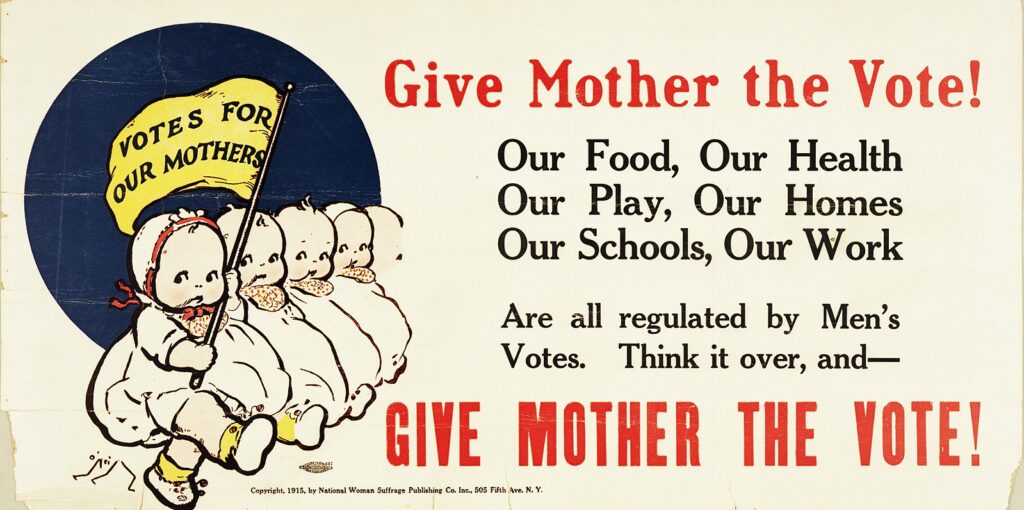
Today in Feminist History is our daily recap of the major milestones and minor advancements that shaped women’s history in the U.S.—from suffrage to Shirley Chisholm and beyond. These posts were written by, and are presented in homage to, our late staff historian and archivist, David Dismore.
October 29, 1915: The final few days and most strenuous, but also the most exciting, phase of the New York State suffrage campaign has begun!
It was kicked off just after midnight this morning, when the Women’s Political Union began 24 hours of continuous speeches at 47th and Broadway. But that was only the first of 250 open-air meetings held today in various parts of New York City by suffrage groups as the November 2nd election approaches, and last-minute arguments are being made to every male voter.
The Woman Suffrage Party has begun its own speech-making marathon at Columbus Circle, and among those expected to take the podium later tonight will be “General” Rosalie Jones. She led her hardy band of suffrage hikers from Newark, New Jersey to Washington, D.C. in February 1913, and on two hikes from New York City to Albany in December 1912 and January 1914.
The rally at Tompkins Square began a few hours ago, and features a band, with Dora De Vera of the Boston Opera Company doing the singing. Another of the big rallies being held tonight is in Madison Square, with music provided by the 100-piece Beethoven Symphony Orchestra. But tonight’s rally in Carnegie Hall was the biggest in town, and was certainly the best advertised.
Not content to just distribute massive numbers of flyers about it, sponsors had young women, led by a bugler, and wearing front and back “sandwich boards” promoting the rally, walking around town from 2 p.m. until just before the meeting began. This was a typical example of the enthusiasm of our entire campaign, because there was really no chance that the event would be less than a sellout thanks to Carrie Chapman Catt presiding, and a number of noted orators making the case for suffrage.
One of the Carnegie Hall speakers was Representative Edward Keating, Democrat of Colorado. He got a laugh when he addressed some of the statements made by our opponents that “Votes for Women” has been a failure in the Western States: “I ride in the subways here in New York and I read the anti-suffrage signs and learn many new things about the West that I never knew before.”
Rabbi Stephen S. Wise’s speech was so well received that he was compelled to do another, and in the encore he said that he wished he could do something similar on Tuesday and vote twice for suffrage. He also talked of the European war, and said that women should have had a say about whether their nations should have become involved: “There will never be a beginning of the end of war until women have such a voice.”
Mothers who favor suffrage have been driving around all day in the “Baby Truck,” decorated with drawings of “Kewpies” by suffragist Rose O’Neill. The truck contains suffrage balloons and toys to be given to children while their mothers go to meetings or listen to speeches given by, and addressed specifically to, mothers. Even though none of the women in the audience can vote, they can certainly influence the men who do vote by using the pro-suffrage arguments they hear.

(Give Mother the Vote / Wikimedia Commons)
The campaign is being run with professional political precision. Several years ago names on suffrage petitions were gathered, then index cards made for each name. In addition to this, polling lists are used to gather more names for the index cards. Canvassers then go out and knock on doors and mark “S” on the cards of those who indicate they’re pro-suffrage, “I” if they’re indifferent, and “U” for unconverted, rather than a more pessimistic “O” for opposed. Use of this information by the campaign could prove to be as effective as anything used by any political machine in the city’s history.
Though no one at the Empire State Campaign Committee would predict exact figures, and the outlook in Rochester and Syracuse is not favorable, there was a universal expectation of victory at its office today. Voter registration is up statewide, and most of these new voters are thought to be pro-suffrage. Speeches have been well received, and the turnout for the parades and other events has been phenomenal.
Alva Belmont, of the Political Equality Association, said today:
Not long ago it was almost impossible to get a man to consider the subject, and now I find that they come into our headquarters and buy literature because they want to understand the question. Miss Florence Harmon, who does most of the speaking for the association is often kept out, with her mother, until 1 o’clock in the morning answering questions. The men are so interested they buy literature off her on the street and give generously to the contributions for the work. As suffrage is only a question of reason and justice, as soon as people begin to consider it they will favor it.
Of course, no amount of confidence will lead to any slackening of efforts between now and November 2nd. In fact, the campaign will continue even on Election Day itself with 2,500 women officially certified in Manhattan alone as poll-watchers. They will be on duty inside the polling places to guard against fraud. There will also be volunteers stationed as closely as the law allows outside of every polling place to give instructions, answer questions, and give out sample ballots showing how to vote for suffrage.
Suffrage organizations are doing everything right—and in just four days we will know if the voters will do their job right as well.





